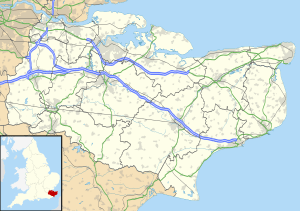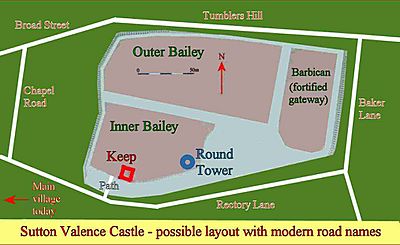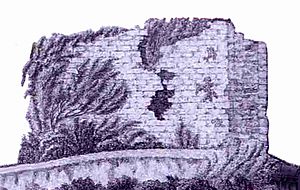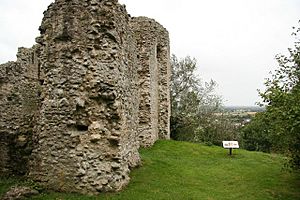Sutton Valence Castle facts for kids
Quick facts for kids Sutton Valence Castle |
|
|---|---|
| Kent | |
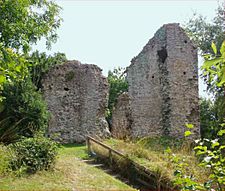
The ruined keep of the castle
|
|
| Coordinates | 51°12′45″N 0°35′52″E / 51.21238°N 0.59775°E |
| Site information | |
| Owner | English Heritage |
| Open to the public |
Yes |
| Condition | Ruined |
| Site history | |
| Built | 12th century |
| Materials | Ragstone and flint rubble |
Sutton Valence Castle is a ruined castle from the Middle Ages in the village of Sutton Valence in Kent, England. It was built to protect an important path leading to the coast. The castle likely had an inner and outer area (called a bailey), a strong entrance (a barbican), and a tall, three-story tower (a keep) on its south side.
The castle was built in the late 1100s, probably by a powerful person named Baldwin of Bethune, who was a Count of Aumale. Over time, it was owned by important families like the Marshals and the de Montforts. In 1265, King Henry III gave the castle to his half-brother, William de Valence. This is where the castle gets its name today! The castle was left empty in the early 1300s and slowly fell apart. Today, English Heritage looks after the castle, and you can visit the remains of its main tower.
Contents
When Was Sutton Valence Castle Built?
Sutton Valence Castle was likely built in the second half of the 12th century, which means between 1150 and 1200. It was probably built by the Counts of Aumale, a noble family. Most historians think Baldwin of Bethune built it, but some believe it might have been his father-in-law, William le Gros.
Why Was This Location Chosen?
The castle was built in a very smart spot. It stood high up, looking over a key route that connected towns like Maidstone, Rye, and Old Winchelsea. This made it important for controlling travel and trade in the area. The place was also known as Sudtone or Town Sutton. The main tower, the keep, was built around the year 1200.
Who Lived in Sutton Valence Castle?
In 1203, Baldwin of Bethune gave the castle to his daughter, Alicia. She married William Marshal, a very important noble known as the Earl of Pembroke. After William passed away, his second wife, Eleanor of Leicester, took ownership.
Eleanor later married Simon de Montfort, who was the Earl of Leicester. Simon led a group of nobles in a fight against King Henry III. This conflict was called the Second Barons' War. Simon de Montfort was defeated and killed in a battle in 1265. After this, Eleanor lost control of the castle.
How Did the Castle Get Its Name?
After the rebellion, King Henry III gave Sutton Valence Castle to his half-brother, William de Valence. William had supported the King during the conflict. It was under William's ownership that the castle and the nearby village became known as Sutton Valence.
William's son, Aymer de Valence, inherited the castle in 1307. The Valence family owned many properties and traveled between them. They stayed at Sutton Valence Castle several times.
After Aymer died in 1324, the castle was passed on through marriage to Lawrence, Lord Hastings. The Hastings family owned it until 1390, when Reginald Lord Grey de Ruthin took possession. There are not many records about the castle after this time. It seems the castle was left empty in the early 1300s and was already a ruin by the 1400s.
What Did Sutton Valence Castle Look Like?
Sutton Valence Castle sits on a hill called the Chart Hills, on the east side of the village of Sutton Valence.
The castle likely had three main parts: an inner bailey (the main courtyard), an outer bailey (another courtyard), and a strong entrance called a barbican. You can still see these parts today as bumps and dips in the ground.
To enter the castle, you would have gone through the eastern barbican and then into the outer bailey. A dry ditch protected the inner bailey, which was about 300 meters long and 34 meters wide.
The castle probably had a large hall, a chapel, and a kitchen. However, the only part of the original buildings that still stands today is the castle's main tower, the keep.
The Castle Keep
The keep is on the south side of the castle site. It is about 11 meters square, with very thick walls (2.4 meters thick). These walls were built from ragstone and flint rubble. Today, they stand up to 7 meters high.
When it was new, the keep was much taller, about 20 meters high, with at least three stories. You would have entered the keep through an outside staircase that led to a doorway on the first floor. The building had a tower in one corner, which held a spiral staircase connecting all the floors. It also had strong supports called buttresses at its corners.
Sutton Valence Castle Today
An old historian named Edward Hasted wrote about Sutton Valence Castle in the late 1700s. He said it was "almost covered with ivy, and the branches of the trees which sprout out from the walls of it." You can see a drawing from his book that shows how the castle looked back then.
In the mid-1950s, people did archaeological digs at the castle site. They focused on the area around the keep. Students from the local Sutton Valence School helped with this work.
In 1976, the castle was put under the care of the state. Today, English Heritage owns and manages it. In the 1980s, important work was done to protect and preserve the ruins.
Sutton Valence Castle is protected by UK law. It is a Grade II listed building and a Scheduled Monument. This means it is a very important historical site.


